Partridge Silkie chickens
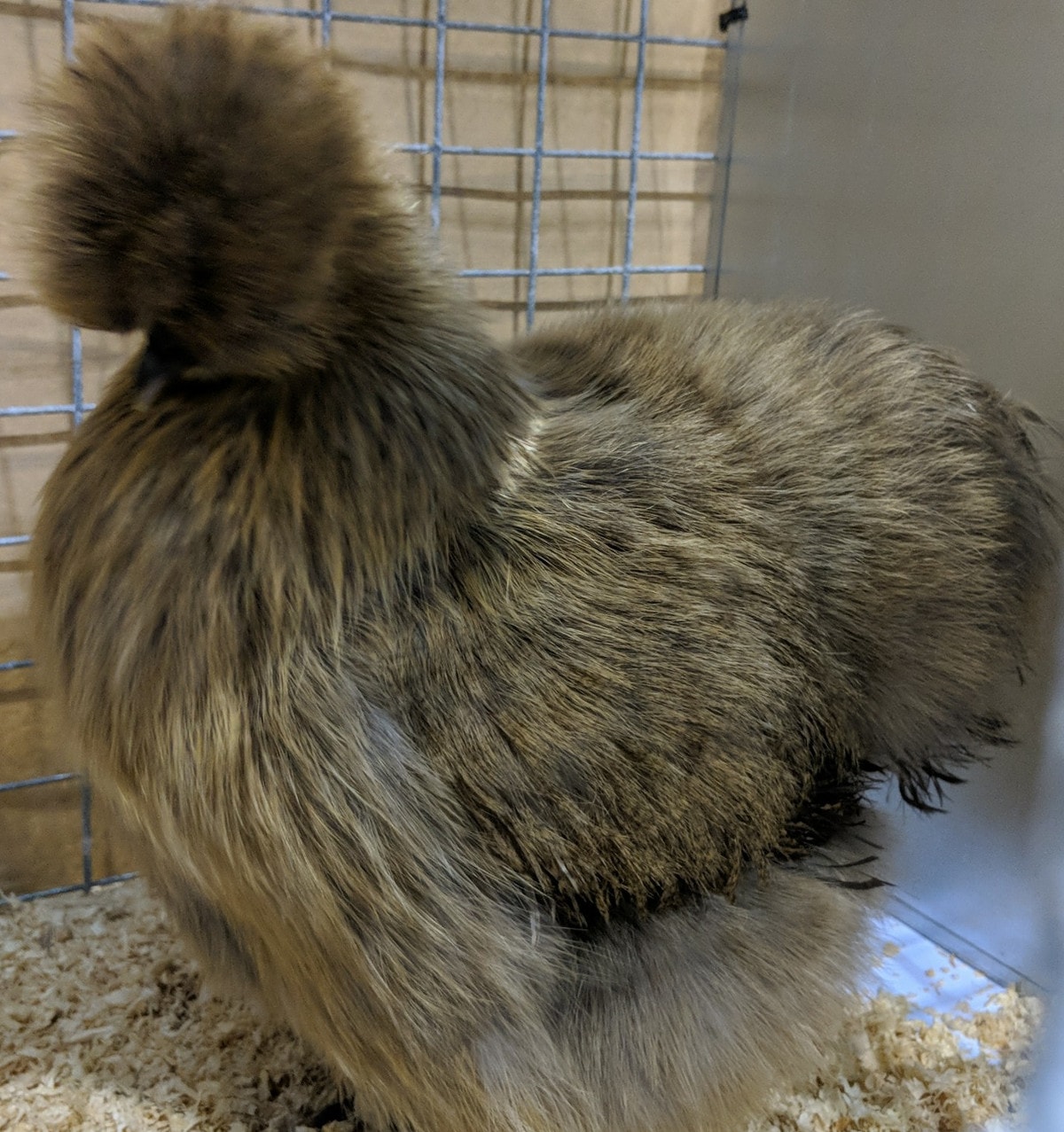
What is partridge feathering?
"Partridge feathering" in chickens refers to the feather colour and pattern on the chicken.
I am pretty sure the one thing you will notice in this article is the variability of the chickens feather patterns and colour.
In chickens the partridge colour pattern is expressed by 6 genes: 2 brown genes, 2 pattern genes and the gold gene of which there are two in males and 1 in females.
Pattern genes express the distinct 3 pencilled pattern found on many of the partridge female's feather's. The brown gene and pattern gene provide the stippling and black pigments to make the pencilling on the feathers and the gold gene adds the red colour to each feather.
Below: A partridge Silkie hen.
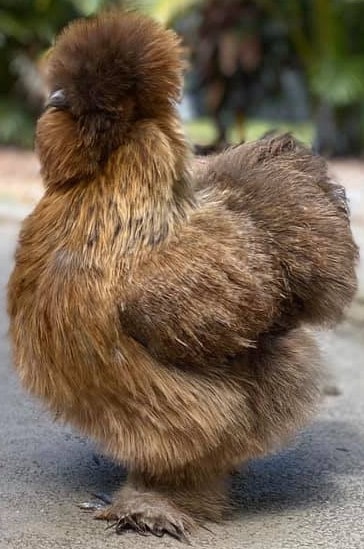
The colour is similar to Black-Breasted Reds and the roosters in particular can be difficult to tell apart.
The real differences show with the hens' feathers feather pattern, the hackle feathers are black in the centre with a thin border of reddish bay and the body colour is the same reddish bay with beautiful black pencillings.
Every feather should have three black pencil lines and they should be even and straight. The main tail is black except for the top two feathers, which follow the same pattern as the body. Done properly the Partridge feathers is stunning. In Silkies it has a habit of looking muddy and spoiled because of the Silkie feathering.
Showing the partridge Silkie:
The only stipulation for partridge is bearded or non-bearded so make sure that you add the bearded or non-bearded when entering Silkies in poultry shows.
The Silkie Standards of perfection state the chest should be black, and that's very difficult to come by in the Silkie.
Below: A partridge Silkie hen showing some common faults.
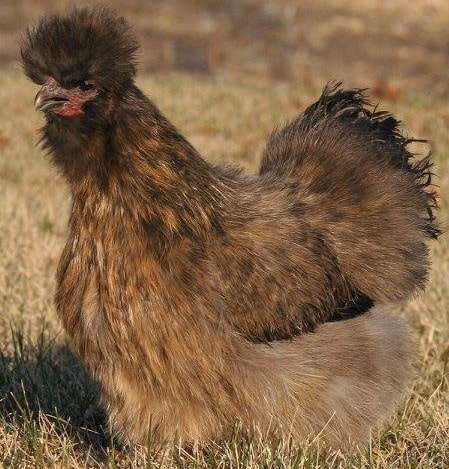
It is common for there to be some hard feathering coming with the partridge gene. This bird above had facial faults.
I have had trouble both breeding and finding good quality show birds.
What does a Partridge Silkie look like?
Interestingly, both male and female have different colours in different places. Very unique characteristic in the Partridge Silkies.
Below: The male partridge Silkie rooster.
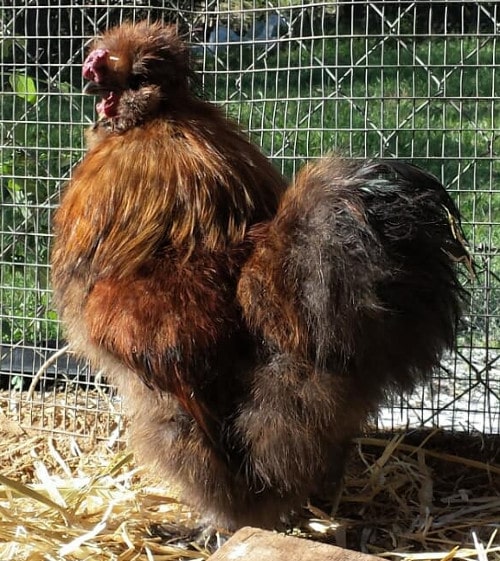
Below: The partridge Silkie hen:

Below: Partridge Silkie chicks.
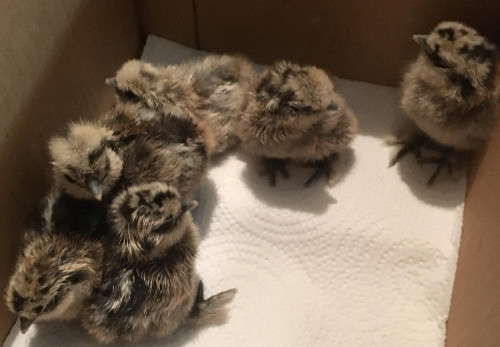
The adult Partridge male will be brighter coloured, dark chest, and dark tail and the female is dull coloured with a dark undercoat with a light buff or red on the top that can be described as reddish bay colour.
Selecting partridge Silkie for breeding:
Partridge is a very difficult colour to perfect, and it comes with hard feather issues as well.
To produce the correct colour of partridge Silkie chicks requires a process called double mating where two different pens produce the correct colour for each sex of chicken. You need to have two different breeding pens.
In one pen you need to use roosters which is darker are used to hatch males with the correct pattern and darker colouring.
A rooster that is redder or has less black is used to hatch correctly marked hens. The double mating system is used to produce properly marked partridge Silkie males and females separately, and this system produces three different types of chicks, dark, light and standard Partridge.
Below: A partridge chick in close up.
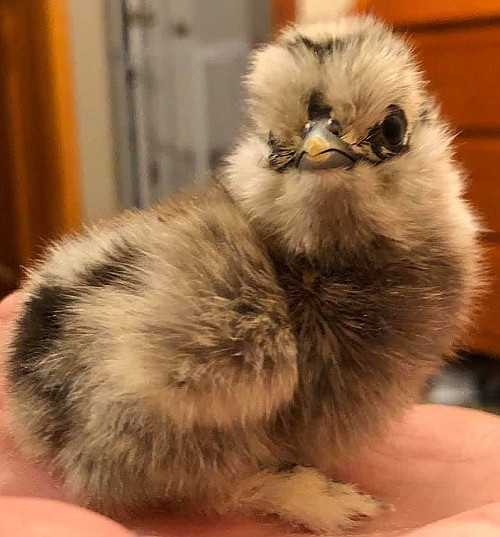
Dark partridge where chicks that are hatched out a solid black, the light partridge where the chicks that are hatched out a buff coloured and the standard partridge where chicks that are hatched out with stripes like a chipmunk.
There are four sub-varieties, that I've found so far of the Partridge Silkie:
- Blue partridge Silkie.
- Silver partridge Silkie.
- Grey partridge Silkie.
- Red partridge Silkie.
The other partridge colours are not excepted into the standard and should be shown as AOV.
Partridge Silkie chicks:
The Silkie chicks that are striped like chipmunks, will eventually develop into partridge Silkie. The stripes are either black or brown that appear on the back and face of the chick.
But do consider the stripes fade away, as the chick grows up. You know the adult partridge Silkie has no stripes.
Sexing partridge Silkie chicks:
The partridge variety in normal feathered chickens makes them easy to sex because the colour patterns are very different in males and females. The females are all golden brown with black pencilling on the feathers in a regular pattern. The males will have solid black breast feathers and bright, deep red in the hackle and saddle.
Partridge are the only Silkies that can be sexed by their colour pattern.
With Silkies the difference is there but more subtle as the pattern and colours are a little more difficult to see clearly in the Silkie feathering.
My reasoning is that since your chicken does not have solid black breast feathers then it must be a female.
Partridge Silkie standard:
Colour of male:
HEAD: Surface of feather, brilliant medium shade of rich red.
NECK: Hackle - surface of feather, lustrous greenish black with narrow edging around entire surface of rich brilliant red; shaft. black: to match saddle. Front of neck - black.
BACK: Surface of feather, lustrous greenish black with narrow edging around entire surface of a medium shade of rich brilliant red. A slight shafting of rich red is permissible. The surface of upper back should appear to be rich glossy red, when viewed from a distance too great to distinguish the individual feathers.
SADDLE: surface of feather, lustrous green black with narrow edging around entire surface of rich brilliant red; shaft black; to match hackle in colour.
TAIL: Main Tail black, shafts black. Sickles & Lesser Sickles lustrous greenish black. Coverts lustrous greenish black, with narrow edging around entire surface of rich brilliant red.
WINGS: Shoulders & Fronts black. Bows medium shade of rich brilliant red. Coverts lustrous greenish black, forming a well defined bar when wing is folded. Primaries black, lower edges of lower feathers, reddish bay, shafts black. Secondaries black, exposed portion of outer web forming wing bay, reddish bay; shafts, black.
BREAST: Lustrous black with greenish sheen.
BODY & STERN: Body black. Stern fluff, black slightly tinged with red.
LOWER THIGHS: Black.
UNDER COLOUR: Slate in all sections.
Colour of female:
PLUMAGE: pencilling in the partridge female should be of uniform width and conform to the shape of the feather. Each feather of the back, breast, body, wing bows and thighs should have three pencillings; the centre black, then alternately reddish bay and black, ending with reddish bay edging around the entire surface.
More attention should be given to the brightness and sharpness of the reddish bay ground colour and the almost jet black pencilling than whether the bird appears lighter or darker than an individual preference. The ideal is one uniform colour over the entire body of the bird.
HEAD: deep reddish bay.
NECK: Hackle surface of feather, centre portion black; slightly pencilled with deep reddish bay. With narrow edging around the entire surface of deep reddish bay. Front of neck same as breast.
BACK: Deep reddish bay with distinct pencillings of black.
TAIL: Main Tail black, except two top feathers, which are deep reddish bay on the upper web, pencilled with black, shafts black. Coverts deep reddish bay, with distinct pencillings of black.
WINGS: Shoulders, Fronts, Bows and Coverts - deep reddish bay, with distance pencillings of black. Primaries black with edging of deep reddish bay on outer webs, shafts black. Secondaries inner webs black; outer webs deep reddish bay, with distinct pencillings of black extending around outer edge of feather, shafts black.
BREAST: Deep reddish bay with distinct pencillings of black.
BODY & STERN: Body - deep reddish bay pencilled with black. Stern fluff, deep reddish bay.
LOWER THIGHS: Deep reddish bay, pencilled with black.
UNDER COLOUR: Slate in all directions.
Disqualifications:
- Positive white in main tail feathers, sickles or Secondaries.
- Shanks other than yellow or dusky yellow.
Defects:
- Purple sheen in males.
- Unevenness of ground colour in females.
- Dullness, mealiness and smokiness in ground colour of females.
- White in under-colour.
- Red on partridge males is not to be so dark as to give the impression that the bird is black.
- No male is to be awarded a first premium if ten percent or more of his breast feathers are other than black.
I have never had that much luck with partridge Silkies and have always struggled to produce good ones and this seems to be a common theme among the breeders. There is also considerable wastage in the double mating process that produces a lot of backyard pets as opposed to show chickens.
